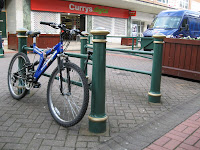This happened in the highly spirited 1960s and 1970s and it seems unlikely that such a movement could be established in the UK now. People in the UK have been ruled by motorised traffic for over 5 decades, so the concept of the "metal box" is deeply rooted in people's minds as the only way of getting from a to b. A silent revolution consisting of local initiatives could bring the change though and I find proof of it in some UK communities.


Cyclists in St. Albans are clearly much better off. The Sustrans National Cycle Network routes 6 and 61 provide access from the outer St. Albans suburbs to its town centre. Although these routes still need some work (they take you through the busy high street without any cycling provision), the potential of a proper cycling network is there and St Albans Cycling Campaign (STCC) has done much to develop it. Various handy cut throughs have been made accessible for cyclists as a result of their "Small schemes, BIG changes" campaign.

This example shows not only how decisions on the creation of cycling infrastructure are made at a local level, but also how public demand can change council view points, just as this happened on a large scale in The Netherlands back in the 1970s. Priorities in highway financing can only be changed by public demand and the St Albans Cycling Campaign shows the best way forward; cyclists organising themselves, creating public debate and continually pressing the local council with ideas and suggestions, small or big.
Remember, if you are a cyclist and you are not prepared to take this on, who else would? The road to succes might be long and full of barriers, but it is worth the effort. For now, I wish St Albans Cycling Campaign all the best and I hope they will be able to change St Albans in a truly cycling friendly town over the years to come; there is still lots of work to be done!
Meanwhile I have followed up the St Albans example in the town where I live, Barnstaple. We set up the North Devon Cycling Forum in 2013 and it is unbelievable how many people suddenly want to talk with you once you get organised! Our study into the future for the cycling infrastructure of this town was published in 2014, but actual progress in conditions for cycling is still very slow. More passionate people are needed to really make a difference...
What about going for a traffic-calmed cycling holiday with one of my "Cycling Dutchman" guidebooks?


The London - Land's End Cycle Route Book is designed for those who LOVE cycling, but don't like traffic. The book takes you onto the most beautiful cycle routes of southern England, including the Camel Trail, Devon Coast to Coast Route, Bristol and Bath Railway path, Thames Valley route and many more! What makes the book unique is that the route is completely continuous, including detailed directions and local knowledge all the way. Get inspired; choose your favourite route sections or go for a full summer holiday adventure; 164 pages, colour, wiro bound, fits in standard handlebar bag, see http://www.london-landsendcycleroutebook.com.
Other popular Cycling Dutchman blog articles:
Other popular Cycling Dutchman blog articles:
Explaining Dutch cycling infrastructure:
Cycle paths and cycle lanes; the full story!
Sharing the road or segregated cycle paths? Well it is both!
